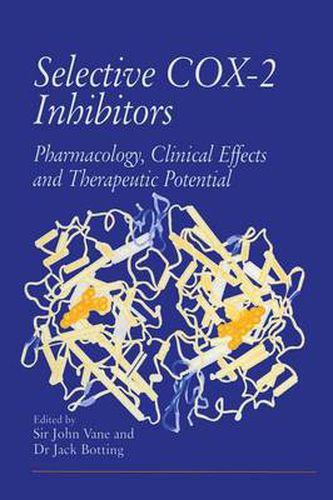Readings Newsletter
Become a Readings Member to make your shopping experience even easier.
Sign in or sign up for free!
You’re not far away from qualifying for FREE standard shipping within Australia
You’ve qualified for FREE standard shipping within Australia
The cart is loading…






This title is printed to order. This book may have been self-published. If so, we cannot guarantee the quality of the content. In the main most books will have gone through the editing process however some may not. We therefore suggest that you be aware of this before ordering this book. If in doubt check either the author or publisher’s details as we are unable to accept any returns unless they are faulty. Please contact us if you have any questions.
The mainstay of therapy for rheumatoid disease is the non-steroid antiinflammatory drugs (NSAIDs), despite their inherent gastrointestinal toxicity and ability to cause renal damage in susceptible patients. The theory that the beneficial and toxic effects of NSAIDs stem from a reduction in prostanoid production through inhibition of cyclooxygenase implied that particular toxicities were inevitable with NSAIDs and would always be correlated with efficacy. However, over the years, it became apparent that at therapeutic doses, some NSAIDs had greater toxic side-effects than others, a fact not explained by the general theory. A significant clarification arose from the discovery that there are two distinct isoforms of COX, a constitutive enzyme (COX-I) responsible for the production of prostanoids necessary for platelet aggregation and protection of the gastric mucosa and kidney; and an inducible enzyme (COX-2) that is newly synthesized at sites of tissue damage and produces prostaglandins that manifest pathological effects. It became clear that different NSAIDs had greater or lesser effects on COX-I when used in therapeutic doses, explaining the variation in side-effects. ‘ The elucidation of the crystal structure of these different enzymes and the skills of medicinal chemists have led to the synthesis of new chemicals with a selectivity for the inducible enzyme, and thus with therapeutic efficacy without those toxic effects result ing from inhibition of the constitutive enzyme.
$9.00 standard shipping within Australia
FREE standard shipping within Australia for orders over $100.00
Express & International shipping calculated at checkout
This title is printed to order. This book may have been self-published. If so, we cannot guarantee the quality of the content. In the main most books will have gone through the editing process however some may not. We therefore suggest that you be aware of this before ordering this book. If in doubt check either the author or publisher’s details as we are unable to accept any returns unless they are faulty. Please contact us if you have any questions.
The mainstay of therapy for rheumatoid disease is the non-steroid antiinflammatory drugs (NSAIDs), despite their inherent gastrointestinal toxicity and ability to cause renal damage in susceptible patients. The theory that the beneficial and toxic effects of NSAIDs stem from a reduction in prostanoid production through inhibition of cyclooxygenase implied that particular toxicities were inevitable with NSAIDs and would always be correlated with efficacy. However, over the years, it became apparent that at therapeutic doses, some NSAIDs had greater toxic side-effects than others, a fact not explained by the general theory. A significant clarification arose from the discovery that there are two distinct isoforms of COX, a constitutive enzyme (COX-I) responsible for the production of prostanoids necessary for platelet aggregation and protection of the gastric mucosa and kidney; and an inducible enzyme (COX-2) that is newly synthesized at sites of tissue damage and produces prostaglandins that manifest pathological effects. It became clear that different NSAIDs had greater or lesser effects on COX-I when used in therapeutic doses, explaining the variation in side-effects. ‘ The elucidation of the crystal structure of these different enzymes and the skills of medicinal chemists have led to the synthesis of new chemicals with a selectivity for the inducible enzyme, and thus with therapeutic efficacy without those toxic effects result ing from inhibition of the constitutive enzyme.